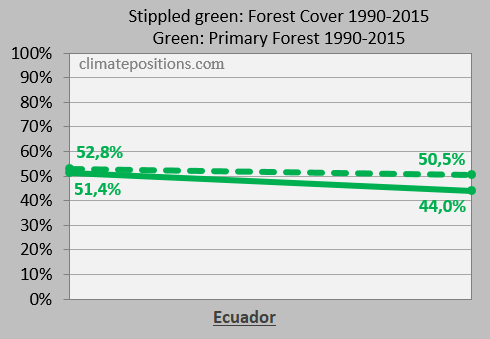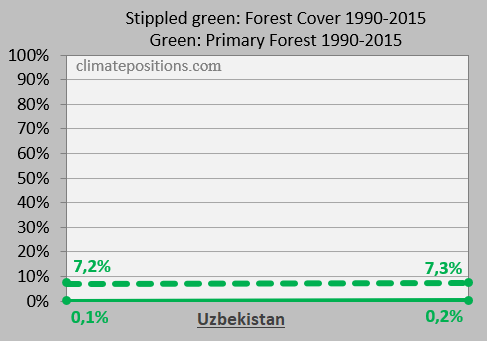Share of global Climate Debt rank 67th, 68th and 69th: Ecuador, Uzbekistan and Cyprus (combined responsible for 0.08% of Climate Debt and 0.44% of Fossil CO2 Emissions 2016)

2018
The diagram below shows ‘Share of global Climate Debt‘ in 2010, 2015 and 2017 of Ecuador, Uzbekistan and Cyprus (ranked 67th, 68th and 69th). The share of Cyprus is continuously decreasing.
The following exposes the key-data in the Climate Debt calculations: Fossil CO2 Emissions, GDP, Environmental Performance, Ecological Footprint without carbon, Forest Cover, Primary Forests, Population trends and climate change financing. For comparison, Equatorial Guinea, Panama and Dominican Republic (ranked 70th, 71st, and 72nd in Share of global Climate Debt) are included in some diagrams.
The ‘Per capita Climate Debt‘ accumulated since 2000 of Ecuador, Uzbekistan and Cyprus are $118, $58 and $1,569, respectively. The second diagram shows the trends between 2010 and 2017, with world average set at 100, for the three countries as well as of Equatorial Guinea, Panama and Dominican Republic. The per capita Climate Debt ranking by October 2017 is shown in brackets.
The next three diagrams show Fossil CO2 Emissions from fuels and industrial processes¹, in tons per capita in decades, of Ecuador, Uzbekistan and Cyprus. The green bars show the Free Emission Level² – the exceedance is the basis for calculating the national Climate Debt. The grey bars are World emissions average.
CO2 Emissions data 1990-2016 (EDGAR) has been updated October 2017.
The three diagrams below show the per capita Fossil CO2 Emissions from fuels and industrial processes¹, annually since 2000, of the three countries. The green bars show the Free Emission Level². The emissions reductions of Cyprus between 2009 and 2013 cannot compensate for an overall poor performance. Uzbekistan’s emissions decrease is nearly acceptable, while Ecuador’s increase is somewhat too steep.
The diagram below shows per capita GDP(ppp-$) of the six countries and the World average. The wealth of Cyprus is 5,0 times greater than the wealth of Uzbekistan.
The next diagram shows the relative Environmental Performance of Ecuador, Uzbekistan and Cyprus, with an average World country set at 100. [Added 25-1-2018: See the new ‘Environmental Performance Index 2018‘]
The average per capita Ecological Footprint without carbon, between 2000 and 2013, with an average World country set at 100, of Ecuador, Uzbekistan and Cyprus are 83, 59 and 111, respectively. Release years are about four years after data years. Note that footprint calculation methods have changed over time. The latest and historic details from the source are available here: ‘Ecuador‘, ‘Uzbekistan‘ and ‘Cyprus‘.
Forest Cover and the precious Primary Forests as percentage of total land area, in 1990 and 2015, are important indicators in ClimatePositions. Cyprus and Uzbekistan have nearly stable forests, while Ecuador’s forests declined significantly, causing 43.1% of the Climate Debt.
The diagrams below show Population density 2016 and growth between 2000 and 2016. The Populations of Ecuador, Uzbekistan and Cyprus are about 16.4, 31.8 and 1.2 million, respectively.
Finally, the table below shows four key values of Ecuador, Uzbekistan, Cyprus, Equatorial Guinea, Panama and Dominican Republic in the calculation of national Climate Debts in ClimatePositions. The price of CO2 per ton (column two) is for total CO2 Emission from Fossil Fuels (without bunkers) and industrial processes. Climate change financing (column three) is from July 2017.
| . | Tons of CO2 | Price per | Climate change | Financing as |
| . | exceeded since | ton CO2 | financing | share of |
| . | 2000, per capita | since 2000 | per capita | Climate Debt |
| . | . | . | . | . |
| Ecuador | 7.89 | $3.21 | $0.00 | 0.00% |
| Uzbekistan | 8.00 | $0.82 | $0.00 | 0.00% |
| Cyprus | 34.79 | $13.25 | $0.85 | 0.05% |
| Equatorial G. | 25.57 | $21.84 | $0.00 | 0.00% |
| Panama | 9.78 | $6.76 | $0.25 | 0.09% |
| Dominican R. | 5.83 | $2.77 | $0.00 | 0.00% |
.
¹Fossil CO2 Emissions include all anthropogenic emissions from Fossil Fuel (combustion and production) and from industrial processes (cement, steel, liming, urea and ammonia production or consumption). The uncertainty in Fossil CO2 emissions is below 5% for industrialized countries and below 15% for developing countries.CO2 Emissions from international shipping and aviation (bunkers) are not included.
²The Free Emission Level (green bars) is determined by national CO2 Emissions 1990-1999 (base), and 11 more ‘Indicators‘, of which 7 are national and 4 are global.
.
Updated data and diagrams of all ‘Indicators‘ and all countries in ClimatePositions are available in the menu ‘Calculations (Excel)‘.
Data on Fossil CO2 Emissions (excluding international shipping and aviation) and industrial processes (cement, steel, liming, etc.) are from EDGAR (European Commission) (links in the menu Calculations / Sources & Links).
Information on national GDP(ppp-$) per capita: Worldbank (links in the menu Calculations / Sources & Links).
Source on Environmental Performance: Yale and Columbia University (links in the menu Calculations / Sources & Links).
Source on Ecological Footprint: Global Footprint Network (links in the menu Calculations / Sources & Links).
Data on national Forest Cover and Primary Forests are from United Nations UN (Report: Global Forest Resources Assessments) (links in the menu Calculations / Sources & Links).
Data on national and global Populations is from Worldbank (links in the menu Calculations / Sources & Links).
PowerPoint collage with flags by Claus Andersen, 2018.
Comments are closed.














